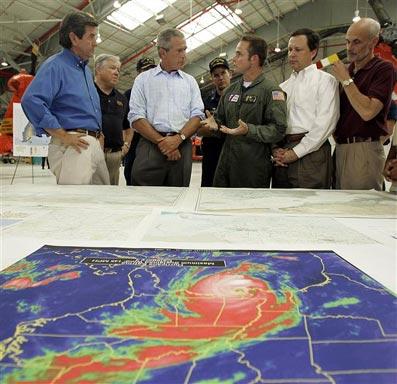Hurricane simulation predicted 61,290 dead
 In the Associated Press photo above, President Bush talks with rescue swimmer Dustin Skarra during a briefing on damage from Hurricane Katrina in Mobile, Alabama, Sept. 2, 2005. Mr. Bush was hoping to boost the spirits of increasingly desperate storm victims and exhausted rescuers. At far right is Michael Chertoff, Secretary of Homeland Security, and to his right is the Director of FEMA, Michael Brown. (Photo: AP/The Mobile Register)
In the Associated Press photo above, President Bush talks with rescue swimmer Dustin Skarra during a briefing on damage from Hurricane Katrina in Mobile, Alabama, Sept. 2, 2005. Mr. Bush was hoping to boost the spirits of increasingly desperate storm victims and exhausted rescuers. At far right is Michael Chertoff, Secretary of Homeland Security, and to his right is the Director of FEMA, Michael Brown. (Photo: AP/The Mobile Register)As Katrina roared into the Gulf of Mexico, emergency planners pored over maps and charts of a hurricane simulation that projected 61,290 dead and 384,257 injured or sick in a catastrophic flood that would leave swaths of southeast Louisiana uninhabitable for more than a year.
These planners were not involved in the frantic preparations for Katrina. By coincidence, they were working on a yearlong project to prepare federal and state officials for a Category 3 hurricane striking New Orleans.
Their fictitious storm eerily foreshadowed the havoc wrought by Category 4 Katrina a few days later, raising questions about whether government leaders did everything possible - as early as possible - to protect New Orleans residents from a well-documented threat.
After watching many of their predictions prove grimly accurate, "Hurricane Pam" planners now hope they were wrong about one detail - the death toll. The 61,290 estimate is six times what New Orleans Mayor C. Ray Nagin has warned people to expect.
"I pray to God we don't see those numbers," Michael Brown, director of the Federal Emergency Management Agency, told The Associated Press. "My gut is ... we don't. But we just don't know."
This according to an article by Associated Press writers Ron Fournier and Ted Bridis with contributions from Kent Prince, AP News Editor in New Orleans, providing details of planning underway when Hurricane Katrina struck.
Under FEMA's direction, federal and state officials began working on the $1 million Hurricane Pam project in July 2004, when 270 experts gathered in Baton Rouge, La., for an eight-day simulation. The so-called "tabletop" exercise focused planners on a mock hurricane that produced more than 20 inches of rain and 14 tornadoes. The drill included computer graphic simulations projected on large screens of the hurricane slamming directly into New Orleans - considered by federal experts to be nearly as big a risk as a terrorist attack on American soil or a massive earthquake in San Francisco.
"We designed this to be a worst-case but plausible storm," said Madhu Beriwal, chief executive of Innovative Emergency Management Inc. of Baton Rouge, hired by FEMA to conduct the exercise.
The experts completed their first draft report in December 2004.
A follow-up workshop on potential medical needs took place in Carville, La., on Aug. 23-24 of this year, bringing together 80 state and federal emergency planning officials as well as Beriwal's team.
They produced an update on dealing with the dead and injured, and submitted it to FEMA's headquarters in Washington on Sept. 3. By then, Katrina had hit and the Bush administration, state and city officials were under heavy criticism for a sluggish response.
The 2004 report was designed to be the first step toward producing a comprehensive hurricane response plan, jointly approved and implemented by federal, state and city officials. But a lack of funding prohibited planners from quickly following up on the 2004 simulation.
"Money was not available to do the follow-up," Brown said.
Continuously updated information can be found at NOLA.com's Hurricane Center, and at the CBS network's Katrina Disaster Blog, which has up-to-the-minute coverage, such as this report today:
September 9, 2005 at 10:24 a.m.
(CBS) — The Washington Post reported that most of the men in FEMA's top leadership positions came to their posts with "virtually no experience in handling disasters." The report scrutinized the experience of five out of the eight men in charge of the agency, "whose ranks of seasoned crisis managers have thinned dramatically since the Sept. 11, 2001, attacks."
Because veterans such as U.S. hurricane specialist Eric Tolbert and World Trade Center disaster managers Laurence W. Zensinger and Bruce P. Baughman have left FEMA since 2003, a "brain drain" of sorts has set in for the agency.
Due to the rapid turnover, three of the five chiefs for natural-disaster FEMA operations are simply "acting" chiefs, the Post reported.
Instapundit Glenn Reynolds comments on CRONYISM AT FEMA and systemic problems with disaster preparedness.